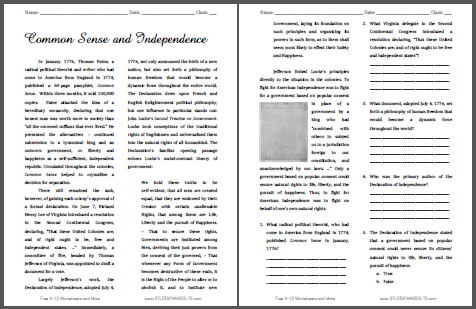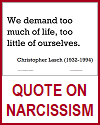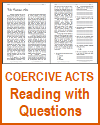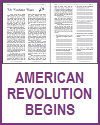Common Sense and Independence |
 In January 1776, Thomas Paine, a radical political theorist and writer who had come to America from England in 1774, published a 50-page pamphlet, Common Sense. Within three months, it sold 100,000 copies. Paine attacked the idea of a hereditary monarchy, declaring that one honest man was worth more to society than "all the crowned ruffians that ever lived." He presented the alternatives – continued submission to a tyrannical king and an outworn government, or liberty and happiness as a self-sufficient, independent republic. Circulated throughout the colonies, Common Sense helped to crystallize a decision for separation.
In January 1776, Thomas Paine, a radical political theorist and writer who had come to America from England in 1774, published a 50-page pamphlet, Common Sense. Within three months, it sold 100,000 copies. Paine attacked the idea of a hereditary monarchy, declaring that one honest man was worth more to society than "all the crowned ruffians that ever lived." He presented the alternatives – continued submission to a tyrannical king and an outworn government, or liberty and happiness as a self-sufficient, independent republic. Circulated throughout the colonies, Common Sense helped to crystallize a decision for separation.There still remained the task, however, of gaining each colony's approval of a formal declaration. On June 7, Richard Henry Lee of Virginia introduced a resolution in the Second Continental Congress, declaring, "That these United Colonies are, and of right ought to be, free and independent states. ...” Immediately, a committee of five, headed by Thomas Jefferson of Virginia, was appointed to draft a document for a vote. Largely Jefferson's work, the Declaration of Independence, adopted July 4, 1776, not only announced the birth of a new nation, but also set forth a philosophy of human freedom that would become a dynamic force throughout the entire world. The Declaration drew upon French and English Enlightenment political philosophy, but one influence in particular stands out: John Locke's Second Treatise on Government. Locke took conceptions of the traditional rights of Englishmen and universalized them into the natural rights of all humankind. The Declaration's familiar opening passage echoes Locke's social-contract theory of government: We hold these truths to be self-evident, that all men are created equal, that they are endowed by their Creator with certain unalienable Rights, that among these are Life, Liberty and the pursuit of Happiness. – That to secure these rights, Governments are instituted among Men, deriving their just powers from the consent of the governed, – That whenever any Form of Government becomes destructive of these ends, it is the Right of the People to alter or to abolish it, and to institute new Government, laying its foundation on such principles and organizing its powers in such form, as to them shall seem most likely to effect their Safety and Happiness. Jefferson linked Locke's principles directly to the situation in the colonies. To fight for American independence was to fight for a government based on popular consent in place of a government by a king who had "combined with others to subject us to a jurisdiction foreign to our constitution, and unacknowledged by our laws. ..." Only a government based on popular consent could secure natural rights to life, liberty, and the pursuit of happiness. Thus, to fight for American independence was to fight on behalf of one's own natural rights. |
Click here to print. Answer Key: (1) Thomas Pane, (2) Richard Henry Lee, (3) Declaration of Independence, (4) Thomas Jefferson, (5) B - False. |
Text courtesy of the U.S. State Department, Bureau of International Information Programs, 2005 |












